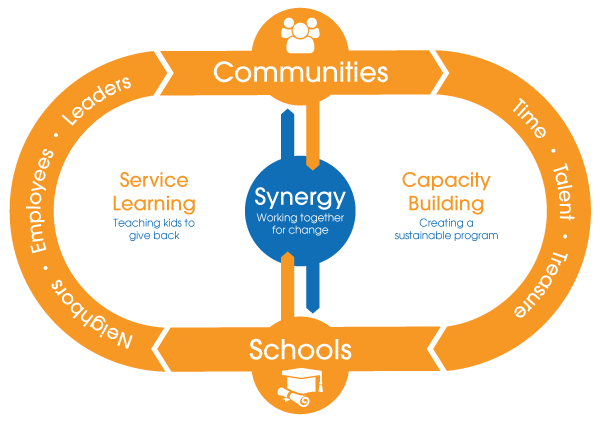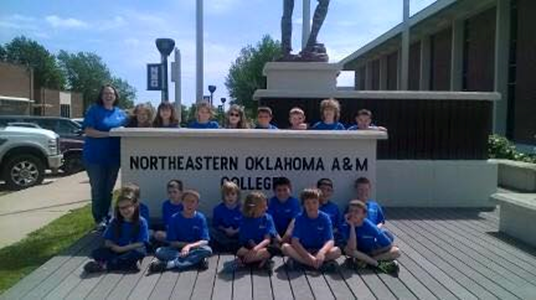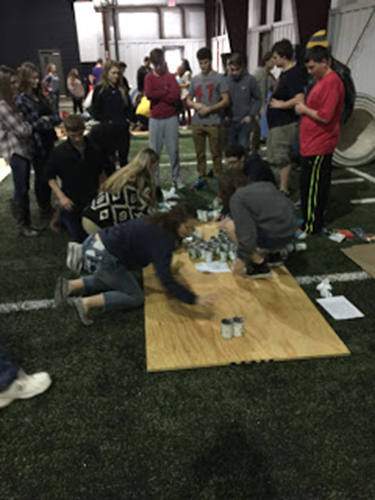Context/Need
Pea Ridge, a small city in Benton County, in Northwest Arkansas close to the headquarters of Walmart,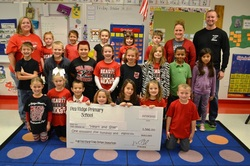 has experienced a growing range of unmet student needs in recent years. While median household income in the city proper is over $57,000, substantially higher than the $40,511 state median, household income varies widely across the areas covered by the school district.1 Just south of Pea Ridge in Little Flock, median household income is over $65,000, and the poverty rate is about 5 percent. On the eastern edge of the school district, in Gateway, median household income is $42,000, and more than 12 percent of residents live below the federal poverty line. Funding for school lunches grew by more than $30,000 between 2011–2012 and 2014–2015 in a district serving just 850 students.2 Challenges ranged from the need for food and clothing among elementary school students to broken homes and homelessness among high school students.
has experienced a growing range of unmet student needs in recent years. While median household income in the city proper is over $57,000, substantially higher than the $40,511 state median, household income varies widely across the areas covered by the school district.1 Just south of Pea Ridge in Little Flock, median household income is over $65,000, and the poverty rate is about 5 percent. On the eastern edge of the school district, in Gateway, median household income is $42,000, and more than 12 percent of residents live below the federal poverty line. Funding for school lunches grew by more than $30,000 between 2011–2012 and 2014–2015 in a district serving just 850 students.2 Challenges ranged from the need for food and clothing among elementary school students to broken homes and homelessness among high school students.
“I had difficulty finding resources that met the needs of kids, and we knew that we were not identifying all the needs that were there. I think that’s the way a lot of districts are.” -Pea Ridge superintendent Rick Neal.3
Response
In 2013, Pea Ridge superintendent Rick Neal, who had been the Pea Ridge high school principal from 2005 to 2012, had no way of addressing students’ needs through school-based strategies alone, and no mechanism for leveraging the resources of the community to meet those needs. Neal saw the potential to address the unmet needs of students and their families through Bright Futures, an organization that uses community-building to tackle poverty-related impediments to learning and student success.
Strategy for Change
With each of its affiliated communities (38 as of December, 2015) Bright Futures works to build grassroots capacity and leadership to meet children’s needs. The goal is to tap the resources of time, talent, and treasure that are unique to each community. All Bright Futures districts commit to three main goals: 1) creating systems to identify and deliver resources to meet any child’s basic needs within 24 hours notice; 2) building community leadership capacity to apply problem-solving techniques to challenges confronting today’s youth; and 3) providing students and teachers in the schools with service-learning; curriculum-based, hands-on service experiences that assist the community while growing generations of service-minded citizens.4
Coalition
Because the mission of Bright Futures is to build capacity within and among communities, the focus is on developing coalitions. In Pea Ridge, the core of the coalition is the school district, which has established partnerships with a range of public and private community organizations. Each partner advances one or more of the three core Bright Futures goals.
School district
The small school district includes one primary school, one intermediate school, one middle school, one high school, and one alternative learning school. Additionally, in 2014, the district opened Pea Ridge Manufacturing and Business Academy; a charter school designed to build on student’s unique strengths and increase their success beyond high school.
Bright Futures USA
As a partner, Bright Futures USA brings three elements to the coalition. The Bright Futures Board of Directors provides oversight to the organization and staff to carry out the mission of Bright Futures. The organization provides training, resources, and ongoing support to Bright Futures affiliate communities. The Advisory Board for each affiliate community consists of faith-based organizations, human-service agencies, business partners, and parents. The boards actively mobilize community resources to tackle district-wide challenges and provide ongoing support to building-level Bright Futures Councils. Each school within a community has its own Bright Futures Council with representation from school faculty/staff, parents, students, faith-based organizations, human service agencies, and the business community. The council’s primary responsibility is to mobilize resources at the school/community level to support teaching and learning.
Private partners
Also part of the coalition are local businesses, including Arvest Bank and Walmart, and faith-based organizations, including local community churches and the Ministerial Alliance.
Comprehensive services
In keeping with the Bright Futures philosophy, Pea Ridge provides supports at both the student level and at the school- and district-wide levels. When a student need is identified internally, a referral is made to the designated school personnel. The appropriate human service agency or nonprofit group is contacted to fill that need. If the need cannot be filled within 24 hours by one of these organizations, the district uses social media to engage the community in filling the need.
If the district is still unable to fill the need, it taps a high-needs fund that is supported by donors. The funds can be used immediately to purchase a needed item or service to support a student. Although seldom used due to the effectiveness of the first two tiers in the three-tier process, the fund can fill gaps, ensuring that any need is met within 24 hours. In addition, Pea Bridge Bright Futures offers a range of in- and out-of-school supports for students and their families:
Early childhood education
The Pea Ridge School District opened its first pre-K program in the 2014–2015 school year. A three-year $300,000 grant from the Endeavor Foundation provided funding for 20 children who meet the requirements for the state’s pre-K program for at-risk children, Arkansas Better Chance (ABC), to attend at no cost.5 The program also offers an additional 20 tuition-based spots, which helps ensure that the pre-K program serves students of diverse races, ethnicities, and socioeconomic status.6
Physical and mental health
Students’ physical health needs are supported by the City of Pea Ridge’s local physician and local dentist, and the Pea Ridge School District’s four nurses, who provide eye exams, flu vaccinations, etc. Students’ mental health needs are supported through a three-tier strategy:
- The school district has designated a social worker to provide individualized support services to students and families based upon needs.
- Three area agencies—Ozark Guidance, Vantage Point, and Day Springs—provide mental health professionals who offer individual, family, and group therapy to students.
- The school district also works closely with these and other area mental health agencies to offer therapeutic day treatment to students whose severe emotional and behavioral issues preclude their participation in the traditional school setting. Providers include Ozark Guidance Therapeutic Day Treatment, Vantage Point Day Treatment, and ALEX Treatment Day Program (which is designed to support high school students).
Mentoring and tutoring
- Lunch Buddies is an on-site program that allows community members to meet at least twice a month with a child—the “lunch buddy”—during the student’s recess/lunch period for the entire school year.
- Car/Bus buddies is a community/business group organized by City of Pea Ridge leaders who welcome and encourage elementary students when they are arrive at school. Car/bus buddies have included the Pea Ridge football Blackhawks’ mascot (Hank the Hawk), Northwest Arkansas Naturals’ baseball mascot (Strike), and Mayor Jackie Crabtree and his staff.
Academic enrichment
- The Pea Ridge Manufacturing and Business Academy (PRMBA), which opened for the 2014–2015 school year, is centered on the philosophy that every student is a Career and Technology Education (CTE) student, and that students should not be limited to only one post-graduation track, college. The goal is to equip students who graduate
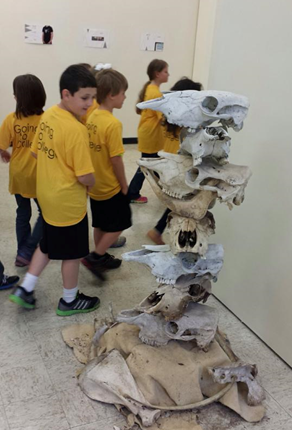 from PRMBA to go straight to work, to attend a two-year community college or technical school, or to attend a four-year college or university, as they choose. Students who are involved in PRMBA have been supported by Bright Futures through donations of work clothing, and with money for certification and for tuition for local community college courses.
from PRMBA to go straight to work, to attend a two-year community college or technical school, or to attend a four-year college or university, as they choose. Students who are involved in PRMBA have been supported by Bright Futures through donations of work clothing, and with money for certification and for tuition for local community college courses. - Pea Ridge Academy provides an opportunity for high-rish students who may have special academic and other needs. Students who attend the academy have fallen behind due to external situations such as pregnancy, poor attendance, or poor support systems in the home. As an alternative learning environment, the academy provides a second chance by letting students work in a small group environment and one-on-one with teachers.
- Academy students also have access to a range of off-campus resources, both academic and non-academic. These resources, some of which are available online, include:
- AR Alternative Education
- Pea Ridge Social Work Services
- R.E.A.P. (Rogers Educational Alternative Program)
- AR Association of Alternative Educators
- National Alternative Education Association
- JAG Resources (Jobs for Arkansas Graduates)
- Students may also regularly participate in hands-on, curriculum-based, service-learning projects that foster citizenship and leadership.
After-school and summer program
- Pea Ridge School District partners with the Rogers Activity Center to provide after-school programs to third- through sixth-graders at the intermediate school gymnasium.
- Pea Ridge primary and intermediate teachers delivered young adult books to children within the Pea Ridge school district during summer 2015. By partnering with Bright Futures and several local businesses, the Pea Ridge Book Bus project helped keep over 183 students engaged and enjoying the love of reading.
Family/social support
The district’s intentional and visible use of social media provides a meaningful way for individual community members to support children by putting the resources they have in their closets, attics, and basements to good use.
- The school district has established a Bright Futures Closet that serves as a central repository donated items that counselors can draw from when ensuring that every child’s basic needs are met.
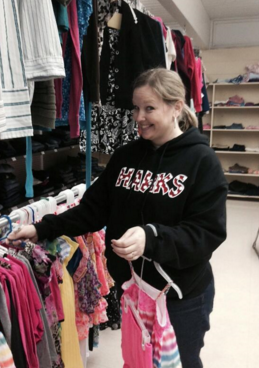
- Pea Ridge School District uses its Bright Futures Facebook page to communicate student and family needs for clothing and other items and to thank those who respond.7 The page also spreads the word about events like Stuff-the-Bus, described below, and service activities for students (through production of videos, etc.).
- The school district’s social workers offer a range of resources through their webpage, including school-based mental health providers, area hotlines for child abuse and neglect, food pantries, rental assistance, and information about local thrift stores. 8 And to simplify application processes,, the page also provides downloadable forms for a range of public assistance benefits, such as low-income housing subsidies and free and reduced-price school meals, and offers to help complete applications.
Bright Futures-affiliated support system
The Pea Ridge School District has adopted several Bright Futures projects that complement its other services for students and their families. These include:
- Bright Futures Closet and Pantry: Pea Ridge Bright Futures manages a local clothing and food donation site that supports other Bright Futures–affiliated events and helps serve students within the district.
- Freedom Fest: During this local festival Bright Futures collect items for the Bright Futures Closet and Pantry.
- Rent the Tent: This fundraising event is held during the Pea Ridge Blackhawk football season.
- Operation College Bound: Bright Futures sponsors this event to take students from kindergarten through 5th grade on tours of local colleges and universities, to encourage their aspirations to postsecondary education.
- Daddy/Daughter Dance: Bright Futures works with the Pea Ridge Parent Teacher Organization to increase school involvement in promoting girls’ positive self-image.
- Cap & Gown and Prom Extravaganza: Bright Futures seeks to eliminate the poverty gap in experience by providing students with opportunities to celebrate reaching important milestones.
- Scholarship program: Through Bright Futures’ fundraising activities, Pea Ridge is able to offer three $1,000 college scholarships to students who have participated in service-learning activities.
- Community service: Bright Futures trains volunteers on school and community policies and practices.
Foundational Policies and Practices
A few core practices and policies have both been instrumental in the progress Pea Ridge Bright Futures has made in its first two-plus years and pose a challenge going forward.
State funding provides benefits that are not necessarily stable or sufficient
The state of Arkansas releases additional funds – National School Lunch Act (NSLA), or school poverty funding – to individual schools based on their level of student poverty, as calculated by eligibility for subsidized meals. Schools use those funds to help meet a range of student needs through services that can include extra instructional aides for Response to Intervention (RTI), school nurses, and social workers. Pea Ridge Superintendent Neal notes that these funds, which he has used to hire a social worker for Bright Futures, are never sufficient to meet the needs and are constantly in danger of being eliminated from the budget.9 He feels that poverty-induced challenges to school success make sustaining these funds challenging:
“There’s a real struggle with state legislators who look at capturing these dollars [by cutting them from the budget], because they see only negative connections between their allocation and student achievement. As a result, superintendents across the state are struggling with this, and I’m telling you, you take these funds away from the things we’re doing, the issues that we’re dealing with, I don’t know how I could do the things I do.”10—Pea Ridge Superintendent Rick Neal
While the state of Arkansas funds a high-quality pre-K program, Arkansas Better Chance (ABC), it has not allocated sufficient funds to serve all of the state’s eligible preschoolers. Pea Ridge, along with many other school districts, does not have funded slots for its three- and four-year-olds, so it turned to a private donor, whose grant, combined with tuition from parents who can afford to pay, currently supports the district’s pre-K program.
Service learning presents both benefits and new challenges
Service learning, which is core to the Bright Futures strategy for empowering students and families, improving communities, and raising academic achievement, has been well established in Pea Ridge. However, superintendent Rick Neal reports that helping teachers to incorporate it into their curricula poses challenges. Teachers need to understand its benefits, see examples of how students can give back, and take time and thought to prepare their own service-learning activities.
Identifying students’ needs goes beyond basic teacher training
Teachers are taught to see their core mission as teaching content, meeting deadlines, and following guidelines. Training them to observe and respond to students’ basic needs is thus an extension of basic teacher preparation for many. To fulfill this need, Pea Ridge offers district-wide professional development on concepts such as understanding poverty and how to look for signs that a student is falling through the cracks. Over the past two years, those professional development strategies have fostered a new tradition of giving back in the schools and the community and significantly enhanced teachers’ personal relationships with students, superintendent Neal says.
Indicators of Progress
Bright Futures has been operating just a few years and thus hasn’t produced a broad enough data set to fully assess its impact on student progress. Nevertheless superintendent Neal sees some clear indications of improvement.
The Pea Ridge district is offering a range of Bright Futures-affiliated supports for students and families
- In August 2015, the back-to-school bash offered all the district’s students and their families school supplies, haircuts, and clothing, and served breakfast to all community members in attendance. This followed the July “stuff-the-bus” event, which provided free school supplies to students who are most in need.
- At Christmas, the school district supports the Angel Tree program, in which families sponsor students (and/or families) who would otherwise not receive gifts during the holidays. In 2016, Community First Bank and Walmart, among others, provided sponsors.
Service learning, one of Bright Futures’ core components, is taking root
- In November, 2015, high school Accelerated Growth Advisory Students (AGS) hosted a canned food drive for the Bright Futures food pantry. AGS students created PSAs and competed with one another to gather more than 3,000 cans of food.
- Service learning is happening among even the youngest district students. The Pea Ridge Primary students held their annual coin drive for the community during the 2015 Fall Festival. This year, students and parents raised $1,586.00 for “Heart and Sole,” a program providing shoes and socks to students in need throughout the district.11
Individual student and school metrics show progress
Because Bright Futures initiatives are shaped by each community’s assets and needs, what one community defines as success is likely to be quite different from how another defines it. As Joplin, Missouri Public Schools superintendent CJ Huff notes,
For example, Joplin was focusing community resources on improving the graduation rate…it worked. In contrast, Columbia, Missouri, has seen a different need, which is about creating more enrichment opportunities for all students, and those efforts are working there. So measuring success among Bright Futures districts really has to happen on a community-by-community basis. Long term, their success will be measured by shrinking the percentage of families living in poverty, parents’ ability to hold a job and support a family, and other such indicators that children, families, and communities are thriving.12
In Pea Ridge, Superintendent Neal seeks indications that the targeted student and family supports are making it easier for students to graduate high school and to transition to the next stages of their lives. Some early examples of progress toward those goals include:
- At the primary and intermediate levels, frequent residential moves disrupt both individual students and their teachers and peers. Two families who have received Bright Futures–related supports have been able to reduce the disruption associated with moving. Support with transportation to Arkansas Children’s Hospital in Little Rock, along with hotel and meal costs, allowed the sick student’s sibling to remain in school at Pea Ridge and the mother to stay with her child in Little Rock. Bright Futures was able to help another family with multiple siblings that was several months behind on utility bills stay in the home by reaching out to local utility companies and helping to offset the cost.
- High school–level supports have helped students participate in extracurricular activities and advanced their career paths.
- Four students who received work boots were thus able to obtain experience in welding, which provided them with a potential career path and encouraged them to stay engaged in school.
- In collaboration with Bright Futures, a Pea Ridge doctor volunteered her time and services to ensure that all students wishing to participate on a sports team can obtain the required physical exam (without which they would be deemed ineligible).
- Clothing donations have enabled various school groups, such as choir, to increase student participation at school assemblies.
- Bright Futures has helped fund Certified Nursing Assistant (CNA) licensing exams for four students, one of whom completed both the written and skills components, making her eligible for entrance into the medical field. The other three still need to pass one of the two parts to advance.13
More efforts are being made to identify the impact of Bright Futures on both schools and the community as a whole. The district is establishing systems to evaluate retention in primary and intermediate schools, school involvement/engagement, attendance, and grades at the middle and high school levels.14
Gains in more established Bright Futures’ communities are encouraging
Bright Futures was launched in 2010 in response to calls for Joplin, Missouri Public Schools superintendent CJ Huff to raise the district’s high school graduation rate. Recognizing the many impediments to students’ school and life success posed by the high rate of poverty in the community, Huff launched a community-wide strategic planning process in the fall of 2008. That process spawned Bright Futures in Joplin.
All Bright Futures affiliate communities commit to upholding certain core values, specifically these beliefs:
- in the inherent worth of every child
- that every child’s basic needs must be met in order for that child to be able to learn effectively
- that education is critical to success
- That every community has the resources to meet the needs of every child, and these resources must simply be brought together
- that every child deserves a chance at success
- that diversity should be celebrated
- in the sanctity of the family unit
- that honesty and integrity are the key to maintaining purity of mission.
- all of us are better together than any one of us alone.
Several indicators of progress are evident, including:
- The number of volunteers increased from 126 in 2010 to 483 in 2015, contributing over 7,706 hours of volunteer service during the 2014-15 school year.15
- The number of community partnerships nearly quadrupled, from 34 in 2010 to 132 in 2015.{16}}
- The number of dropouts in a cohort fell by more than 50 percent, from 131 out of 510 (in the class of 2008) to 57 out of 532 (class of 2015).{17}}
- Graduation rates increased from 74.3 percent in 2008 to 86.3 percent in 2015.{18}}
- Cash and in-kind donations from the community to support student success has exceeded $500,000 annually since the inception of Bright Futures.{19}}
As a result of the success of the Bright Futures effort in Joplin, many other surrounding communities asked to replicate the effort.
- In February 2011, the organization attained nonprofit status, and by the end of that year, there were five Bright Futures affiliates in Missouri.
- As of 2015, Bright Futures was active in 38 communities throughout Missouri, Kansas, Arkansas, Oklahoma, Iowa, North Carolina and Virginia.{20}}
Contact
Rick Neal, superintendent, Pea Ridge Public Schools, [email protected], (479)228-2059, or visit www.facebook.com/BrightFuturesPeaRidge
Endnotes
1. “Pea Ridge, Arkansas (AR) income map, earnings map, and wages data,” City-data.com.
2. http://www.prs.k12.ar.us/uploads/2/5/9/9/25990010/copy_of_revenue_sources_through_2014_15_actual.pdf
3. From email correspondence with Elaine Weiss, December 2015. Unless otherwise noted, information and details about the district were provided by Pea Ridge School District superintendent Rick Neal and/or district staff.
4. “Why Bright Futures?” Bright Futures USA (website).
5. While the state does fund the high-quality ABC program, no funds were available in 2014–2016 to add Pea Ridge students, so this funding makes pre-K privately available to students who qualify for ABC but lack access.
6. “Pea Ridge Pre-K,” Pea Ridge School District (website).
7. https://www.facebook.com/BrightFuturesPeaRidge. According to Bright Futures founder and former Joplin, Missouri, superintendent CJ Huff, Facebook has been a critical tool for the Joplin and subsequent Bright Futures affiliates to connect community members with unmet needs to resources within the community and in nearby communities.
8. Pea Ridge Social Work Services (website).
9. Benjamin Hardy, “Education Committee Leaves NSLA Funds Flat for Fourth Year, Waits on Teacher Salary Increase.” Arkansas Times. October 14, 2014.
10. Conversation with Elaine Weiss, November 2015.
11. “Primary School Coin Drive,” Blackhawk Brag Page, Pea Ridge School District.
12. From email communication with Elaine Weiss, November 2015.
13. Students took these exams on January 6 and 7, 2016. (Elaine Weiss email correspondence with Pea Ridge superintendent Rick Neal on January 8, 2016).
14. The district’s social worker began to collect data on individual students from each school starting in the fall of the 2015–16 school year. Spring data collection will assess specific students whose needs were met in the fall in order to
15. Data from email from Melissa Winston, Joplin Bright Futures Coordinator, and “Bright Futures Financial Overview,” Joplin School Board report dated October 27, 2015
16. Data provided by Melissa Winston, BF Joplin Coordinator, date
17. Data from Missouri Department of Elementary and Secondary Education and Joplin High School Administration.
18. Data from Missouri Department of Elementary Education and Joplin High School Administration.
19. “Bright Futures Financial Overview,” Joplin School Board report dated October 27, 2015.
20. “Our History, A Bright Idea,” Bright Futures USA website.
